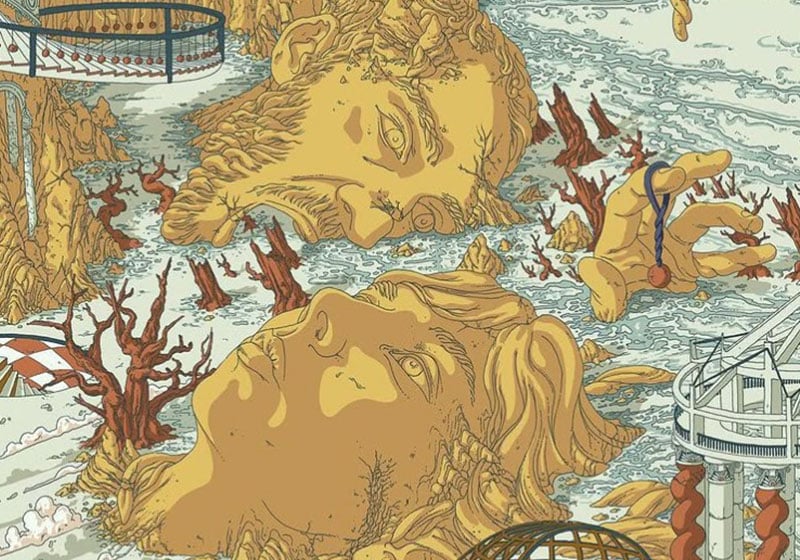Table of Contents
Within the 100+ years of evolution in Olympic posters, those designed by Ugo Gattoni for the Paris 2024 Games already occupy a very prominent place in history. They depict a city-stadium in which the monuments, symbols and major characters of the French capital are all in attendance, a project in which the artist invested more than 2,000 hours of work, as we detailed in this article.
But long before embarking on this mammoth project, the French illustrator had already made a name for himself in the global art scene for his large-scale surrealist landscapes with intricate details, inspired by mythology, ancient civilisations and architecture, the objective of which is to invite the viewer to dream.
Early work
Gattoni was born in 1988 in Vitry-sur-Seine, a suburb in the south of Paris, and became an illustrator after studying graphic design at EPSAA (École d’art publique de la ville de Paris), where he graduated in 2010. For six months, he dedicated himself to a large-scale personal project: an illustration 10 metres long and 1.2 metres high, depicting his daily life with his friends. It ended up becoming an exhibition at the Galerie Surprise in his hometown, with the name “Ultra copains”, in 2011.
A year later, his passion for cycling was captured in “Bicycle”, a giant concertina book commissioned by the publisher Nobrow Press, to commemorate the London 2012 Olympic Games. Along 5 metres, the artist illustrates a race with multiple scenes of bicycles on the streets of London, featuring not only professional cyclists but also travellers, bankers, couriers, mothers with children, etc. The piece, in which he invested 723 hours of work, caught the attention of Hermes.
Collaborations with Hermès
In 2013, the prestigious French fashion house proposed Gattoni his first collaboration. Over the next few months he worked on “Hippopolis”, a silk scarf that was launched worldwide in late 2015 in various colours. The design, depicting an imaginary city, pays homage to the horse. The animal is shown leaving its hot air balloon to explore the nooks and crannies of the monuments staged on a chessboard.
Since then, the illustrator has worked periodically for Hermès, a brand that allows him to work with total freedom and respects the time required for a creation with this level of detail.
In addition to scarves, Gattoni was also behind the creation of Mino, the fun mascot used for the opening of the new Hermès store in Seoul in 2017.
Imaginary universes
Aside from Hermès, brands such as Cartier, Rolex, Hennessy, Nissan, Motorola, Nike and Iittala have also chosen to have their products put through the lens of the French artist’s fantasy worlds. For Pierre Frey, for example, he designed an illustration that told the story of the resurrection of a world of titans buried under the rubble of a city, lost in the midst of clouds and mountains, for the launch of their autumn 2016 wallpaper collection.
A year later, Ruinart, the oldest winery in the French region of Champagne, commissioned him to capture the harvesting process. The result is “Rebond”, which describes the steps taken for the transformation from the grape through to the shipped bottle.
Later, in 2020, the French perfume house Diptyque asked him to invent a winter tale for the launch of their “Marvellous Beasts” Christmas scented candle collection. Gattoni’s drawings immerse us in an adventure in which a lion, a swan and a crow meet and enter a snow-covered city in search of new scents.
More recently, the artist has explored new paths, such as illustrating album covers and designing posters for music festivals.
In recent years, however, Gattoni has devoted much of his time to designing his own imaginary universe, called “Nebula”. It is a journey between several worlds, from the Earth to the cosmos, for which he has established everything from its fauna and flora, to its cartography, clothing customs, currency and beliefs. It is a mythological tale structured around the idea of infinite happiness as the driving force of a wonderful world.
Creative process
Gattoni’s work process comprises three phases: sketching, design and shading, for which he chiefly uses graphite and rotring pencils. He sketches the original drawings on a roll of paper, which he unrolls as he continues to draw elements, and then scans them. He only uses digital tools to finish and polish the drawings, and for some commercial commissions. If he makes a mistake it can easily be concealed thanks to the wealth of details.
This is how the French illustrator fleshes out his pieces, rich in architectural and sculptural dimensions, broad in their philosophical, anthropological and even botanical scope, to ensure that his scenes are totally immersive.

